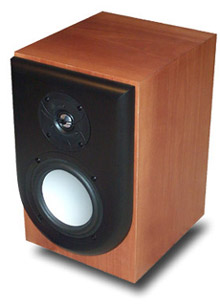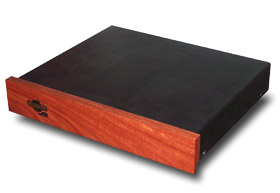![[SoundStage!]](../sslogo3.gif) Standout Systems Standout SystemsBack Issue Article |
| February 2001 Diminishing Returns There’s long been a trend in high-end audio to shoot straight for the stars. What I’m talking about here are the cost-no-object, mega-thousand-dollar components -- the stuff that audiophiles drool over and reviewers crave, and about which most others ask, "Who would buy that?" Whether many can actually afford this gear or not is another story. Still, audiophiles flock to and fixate on it, hence the megabuck systems we’re seeing today, some even approaching a million dollars! However, when all is said and done, the obvious question arises, "Do you really need to spend that much money to get really great sound?" The answer is, quite simply, no. For even hundreds of dollars you can assemble quite a good system. If you have a budget of $1000 to $2000, you can have a real field day -- I can think of lots of equipment I would buy. Today is a great time for bargain-basement audiophiles. Still, not everyone wants to shop on the cheap. While the low-priced gear can be fun and rewarding, I’ve always found the most pleasure in equipment that represents the pinnacle of value -- the point at which you get a really great piece of gear, in terms of design and build, and not feel like you’re getting something compromised, the point at which any money over and above that amount give you less performance than what you spent up to that point. It’s known as the law of diminishing returns. Numbers If I were to pick an arbitrary dollar figure as to where exactly the law kicks in, I would have to say $2000 per component. I look around and can easily find fantastic $2000 speakers that meet this criteria and that I could live with. At this price point, almost all the manufacturers use real-wood veneer, or some other type of finish that sets their speakers apart from the budget crowd. In a nutshell, you can get something really good. Sliding over to electronics, $2000 can buy a heckuva nice power amp or preamp or integrated amp. And like the speakers in wood, at this price point you would get all-metal chassis with a solid look and feel. For digital front-ends, I don’t think you even need to spend close to that amount of money. Frankly, I think that today the $2000 figure is rather high (it was more appropriate a couple years ago before inexpensive digital got so good). Today I think the diminishing returns set in for digital playback at about $1500. For that you can get a great-sounding player that’s built nicely and in terms of sonic performance gives the cost-no-object players of a couple years ago more than a run for their money (and may just beat them!). In summary, at all these price points you can buy extremely well-engineered, nicely built, and most importantly, great-sounding components that will rival the best available today. In fact, I’ll describe some below that I happen to be reviewing. Components
I found that these speakers work best with a bit of power behind them. Enter the $1700 Redgum RGi120 integrated amplifier. I’ve written about this piece of gear a number of times already. We’ve not only awarded it our Reviewers’ Choice designation, but it also received our year-end Best Product Debut award. I’ll save the screen space and recommend you read the review to get the whole scoop, but I will summarize it as a compact and elegant design with sparse features but great sound. Its smooth and easy presentation, along with ample power (120Wpc), proves a very good match to the M20s. As well, its price easily fits into the range I specify.
As for cabling, my $2000 price point wasn’t really meant to apply to that. Frankly, I don’t think you have to spend anywhere near that much, even for the whole system. I was only referring to components. But for reference, in this system I used Nordost’s Red Dawn II for speaker wire, as well as a new interconnect from Blue Circle. There are other options worth exploring too. Wrapping up So there you have it, a system that is exceedingly simple but simply outstanding in terms of the musical presentation it offers. Could I do better if I spent more money? Oh definitely. But how much more I’d have to spend is the key! And how much better that system would be is another story. All I know is that if I doubled my budget I would seriously doubt that I could get double the sound quality and that’s what's important when you’re looking for true value. ...Doug Schneider
|
|
![[SoundStage!]](../sslogo3.gif) All Contents All ContentsCopyright © 2001 SoundStage! All Rights Reserved |
 A speaker that I’ve
recently become quite fond of is the Revel Performa M20. It is an extremely
well-designed speaker that offers an exceedingly high level of performance. A speaker at
this price point does not give you everything, but it does get you a good measure of
what's possible. In this instance, what the M20s give up is some bass extension. Remember,
in speaker design it costs big money to get big bass -- I can live with that. What you
gain is a top-notch speaker with exemplary performance through the rest of the spectrum.
The M20 has unbelievable clarity and detail, and the ability to cast a huge and expansive
soundstage. As well, it has an almost unnerving clarity that, to these ears, sounds
breathtakingly real. It’s a speaker that I describe in the forthcoming review as
"honest," and that’s the highest praise I can give it. Its price hits my
number right on the head -- $2000 per pair in a choice of real-wood finishes. If you need
stands, Revel offers specially built stands that screw into the bottom of the speakers for
only $200 more.
A speaker that I’ve
recently become quite fond of is the Revel Performa M20. It is an extremely
well-designed speaker that offers an exceedingly high level of performance. A speaker at
this price point does not give you everything, but it does get you a good measure of
what's possible. In this instance, what the M20s give up is some bass extension. Remember,
in speaker design it costs big money to get big bass -- I can live with that. What you
gain is a top-notch speaker with exemplary performance through the rest of the spectrum.
The M20 has unbelievable clarity and detail, and the ability to cast a huge and expansive
soundstage. As well, it has an almost unnerving clarity that, to these ears, sounds
breathtakingly real. It’s a speaker that I describe in the forthcoming review as
"honest," and that’s the highest praise I can give it. Its price hits my
number right on the head -- $2000 per pair in a choice of real-wood finishes. If you need
stands, Revel offers specially built stands that screw into the bottom of the speakers for
only $200 more.  As a source to this pairing, I’ll briefly describe
another fine-sounding Redgum piece, but one that I have not yet spilled any ink on. The
$1600 RGCD5 CD player is certainly a unique piece from this Australian company. Calling it
a CD player is not really all that accurate since the company touts it as a DAC "with
compact disc compatibility" -- a description that makes sense when you make note of
its exceedingly sparse feature set. Still, it does play CDs and is an
all-in-one-box unit. You’ll have to wait for the full review to get the real skinny
on the player since it is a bit of an idiosyncratic piece of gear, but in terms of sound
quality I found it the equal of RGi120 -- smooth, clear, seductive and completely
grain-free. It rounds out this system quite nicely and fits well with the prices I
specified.
As a source to this pairing, I’ll briefly describe
another fine-sounding Redgum piece, but one that I have not yet spilled any ink on. The
$1600 RGCD5 CD player is certainly a unique piece from this Australian company. Calling it
a CD player is not really all that accurate since the company touts it as a DAC "with
compact disc compatibility" -- a description that makes sense when you make note of
its exceedingly sparse feature set. Still, it does play CDs and is an
all-in-one-box unit. You’ll have to wait for the full review to get the real skinny
on the player since it is a bit of an idiosyncratic piece of gear, but in terms of sound
quality I found it the equal of RGi120 -- smooth, clear, seductive and completely
grain-free. It rounds out this system quite nicely and fits well with the prices I
specified.